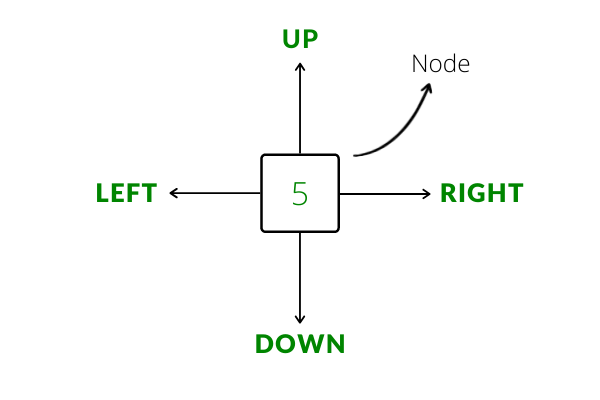正交链表是一种由称为节点(类似于链表)的基本元素组成的数据结构。正交链表中的每个节点都指向另外4个节点,分别是上、下、左、右。本质上,就像矩阵是数组的二维版本一样,正交链表是线性链表的二维版本。

将矩阵转换为正交链表的算法:
- 为矩阵中的每个单元格创建一个节点。在映射中,还存储单元格的值和指向为单元格创建的节点的指针。
- 如果当前行(i)不是矩阵的第 0行,则将当前节点的向上指针设置为它正上方单元格的节点(使用映射获取正确的指针)并将上面节点的向下指针设置为当前节点。
- 同理,如果当前列(j)不是矩阵的第0列,则将当前节点的左指针设置为当前节点左边的单元格的节点,将左边的节点设置为当前节点的右指针节点
- 对矩阵中的每个单元格重复过程 1 到 3
- return map[matrix[0][0]] 返回指向正交链表左上节点的指针
下面是上述算法的一个实现。
Input:
matrix = {
{1, 2, 3},
{4, 5, 6},
{7, 8, 9}
}
Output:
A Node pointing to the top-left corner of the orthogonal linked list.
^ ^ ^
| | |
<--1 <--> 2 <--> 3-->
^ ^ ^
| | |
v v v
<--4 <--> 5 <--> 6-->
^ ^ ^
| | |
v v v
<--7 <--> 8 <--> 9-->
| | |
v v vC++
#include
using namespace std;
struct MatrixNode
{
int _val;
MatrixNode* _u; // pointer to node above
MatrixNode* _d; // pointer to node below
MatrixNode* _l; // pointer to node towrads left
MatrixNode* _r; // pointer to node towards righ
// Constructor for MatrixNode
MatrixNode( int val = 0,
MatrixNode* u = nullptr,
MatrixNode* d = nullptr,
MatrixNode* l = nullptr,
MatrixNode* r = nullptr )
{
_val = val;
_u = u;
_d = d;
_l = l;
_r = r;
}
};
MatrixNode* BuildOrthogonalList(int matrix[][3], int r, int c)
{
// an unordered_map to store the {value, pointers} pair
// for easy access while building the list
unordered_map mp;
for(int i = 0; i < r; i++)
{
for(int j = 0; j < c; j++)
{
// create a newNode for each entry in the matrix
MatrixNode* newNode = new MatrixNode(matrix[i][j]);
// store the pointer of the new node
mp[matrix[i][j]] = newNode;
// set the up and down pointing pointers correctly
if(i != 0)
{
newNode->_u = mp[matrix[i - 1][j]];
mp[matrix[i - 1][j]]->_d = newNode;
}
// similarly set the left and right pointing pointers
if(j != 0)
{
newNode->_l = mp[matrix[i][j - 1]];
mp[matrix[i][j - 1]]->_r = newNode;
}
}
}
// return the start of the list
return mp[matrix[0][0]];
}
void PrintOrthogonalList(MatrixNode* head)
{
MatrixNode* curRow; // will point to the begin of each row
MatrixNode* cur; // will traverse each row and print the element
for(curRow = head; curRow != nullptr; curRow = curRow->_d)
{
for(cur = curRow; cur != nullptr; cur = cur->_r)
{
cout << cur->_val << " ";
}
cout << endl;
}
}
int main()
{
int matrix[3][3] = {
{1, 2, 3},
{4, 5, 6},
{7, 8, 9}
};
MatrixNode* list = BuildOrthogonalList(matrix, 3, 3);
PrintOrthogonalList(list);
return 0;
} 应用:
正交链表最常见的应用是稀疏矩阵表示。简而言之,稀疏矩阵是其中大部分元素为零(或任何已知常数)的矩阵。它们经常出现在科学应用中。将稀疏矩阵表示为二维数组是一种巨大的内存浪费。相反,稀疏矩阵表示为正交链表。我们仅为矩阵中的非零元素创建一个节点,在每个节点中,我们存储值、行索引和列索引以及指向其他节点的必要指针。这节省了大量的性能开销,并且是实现稀疏矩阵的最节省内存的方式。